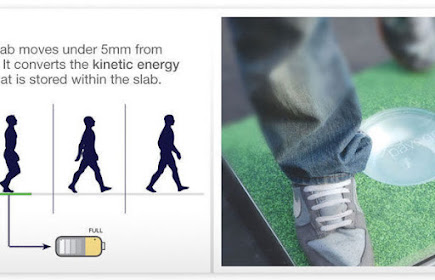Kinetic Paving - An Ecosystem to generate electricity from foot steps
Kinetic Paving
Introduction
Most countries try to innovate alternative electricity power for their usage. In Civil Construction filed, we are introducing an energy-conserving technology as a replacement for tiles. Also, known as Kinetic footfall.
This tile flexes by 5mm when stepped on, resulting in
up to 8 watts of kinetic energy over the duration of the footstep. Every step
is good for about 3 joules of energy, which could light a LED street lamp for 30 seconds. Enough tiles and enough footsteps can create enough energy to
be stored in batteries, or help power electrical items.
Objectives of the Study
- Deploying renewable energy is to advance economic development, improve energy security, improve access to energy, and mitigate climate change.
- To find solution to substitute fossil fuel to renewable energy.
- To reduce the different types of pollutions by minimizing the use of fossil fuels
Types of floor Mechanism
- Piezoelectric effect.
- Magnetic Transducers.
- Micro- generators.
- Static capacitors.
Advantage
- These tile can be used indoors or outdoors in high traffic areas, and generates electricity from pedestrian footfall
- The top surface is built entirely of recycled material
- Harvesting human power to produce energy is best practice in order to fulfil the energy demand.
- To reduce the global warming caused while using traditional carbon fuels.
- Less maintenance cost.
- If we implement this technology, we can supply the power to grids such as pedestrian lighting.
- Tiles are completely Renewable & Eco friendly technology.
- We can reduce approximately 6.817 tons of excessive CO2 every day emission by tiles into atmosphere, by using kinetic technology.
- Its waterproof and damp-proof
Disadvantage
- Low amount of energy is produced during each step or movement of the slab
- Initial cost is extremely high
- Uncertainly about economic life
- It cannot be used as a primary energy sources.
Conclusion
Promoting energy awareness is an integral part of this proposal. Paving tiles have been capable for generating 40V. They are particularly suitable for implementation in crowded areas. It is a future energy renewable resource using kinetic energy. The results of this study are that energy can still be produced by humans as easily as possible by utilizing existing resources.
The use of kinetic paving is very useful in producing electrical energy which is an alternative energy for facilities and buildings. This kinetic paving will become a material technology that will compete with the international market. Kinetic paving is also an educational medium for the cloud community regarding energy conversion and material technology.
Kinetic Paving can be an alternative energy that helps outdoor facilities such as USB ports, street lights, and electricity supplies in buildings. Kinetic paving is also a progress in the field of materials technology with a sustainable and futuristic approach.


Comments
Post a Comment